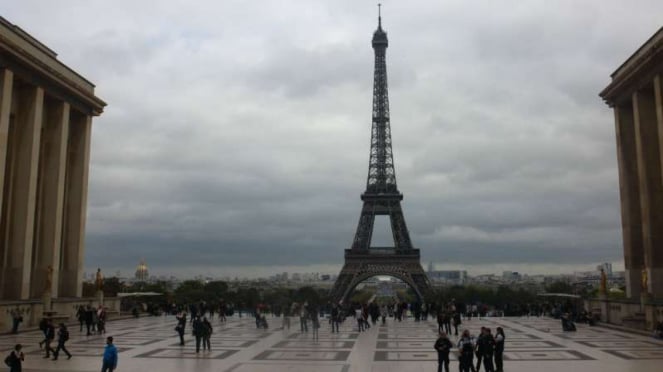Ten Famous and Most Brazen Con Artists in History
VIVA – Being a confident scammer takes a lot of brave, like looking someone in the eye, lying to them, and trying to earn someone's trust.
Scammers are usually able to trick their victims who are willing to spend a lot of money on these scammers. The scammers will get a lot of money from the results of their acts. As it turned out, many scammers disguised themselves as artists who dared to lie.
Here are ten of the most famous and most brazen con artists in history, as quoted from the toptenz.net page:
1. Frederic Bourdin (Pretended to be Children)
Ilustrasi anak di bawah umur nonton konten pornografi
- iStock Photo
Frederic Bourdin left a trail of fraud throughout Europe and in the United States. When he was 31 years old, he managed to convince school officials and students that he was a 15-year-old orphan. he said that he was mistreated for a whole month while she attended classes and tried to make friends with other people.
Bourdin managed to trick people into getting money from other children and other people around him. He says that he is a manipulator and he even has a tattoo on his arm that reads “Chameleon from Nantes” which is the name of the city where he grew up.
His deception in Spain, where he plays an orphan, ends when a school official happens to see a TV show about Bourdin and recognizes his face.
2. The First International Bank of Grenada
Ilustrasi penipuan lewat sms.
- VIVAnews/Adri Prastowo
In 1997, Van Brink purchased the license to open his bank in Grenada. He convinced the government by buying him citizenship that he was legitimate by claiming he had a giant ruby, complete with photos and a $20 million valuation.
The ruby ??does exist but it doesn't belong to him. Nonetheless, with another $26 billion in asset collateral, the bank was formed and within a year it had assets of US$14 billion.
The bank has managed to defraud investors of $170 million. The bank claimed to have insurance, but it was issued by another fake company. Investors were promised high-interest rates but in reality, Brink and partners only bought luxury goods and used investments from new investors to pay fake interest to older investors, all until the scam collapsed.
Van Brink fled to Uganda, denying any wrongdoing at all times. He was eventually charged but died of a heart attack while awaiting trial.
3. Victor Lustig (Sold the Eiffel Tower Twice)
Menara Eiffel Paris, Prancis
- VIVA/Ezra Natalyn Sihite
t, there was a skilled con artist from Austria-Hungary, Victor Lustig, who had a career in crime involving deception throughout Europe and the United States in the early 20th century. In 1925, the French government lamented the poor condition of the Eiffel Tower, and apparently, an official made a direct statement to a newspaper about selling it as a second-hand item. Lustig read this and executed the plan.
He made fake stationery that listed him as a government official and invited a local secondhand dealer to meet him.
He told dealers that the tower, which was never meant to be permanent, is being torn down and whoever has the best bid for 7,000 tonnes of junk can claim it all. At the same time, he convinced his favorite target among dealers that if they lubricated the wheels, the contract would be theirs.
Bribery in hand, Lustig leaves the country and waits for news of the fraud to come to light. That never happened, probably because the victim's shame prevented them from advancing.
So Lustig did what a successful conman would do: he returned to France and committed the same scam a second time with a new victim. When he escaped this time, the victim reported the crime but Lustig was already in the United States.
4. Arthur Furguson (Sold Landmarks in England and America)
In 1925, Victor Lustig sold the Eiffel Tower in France, the Scotsman Arthur Ferguson successfully sold Nelson's Column, Big Ben, and Buckingham Palace to American tourists visiting London. Then, he went to the US and sold the White House to a Texas rancher and the Statue of Liberty to an Australian.
In England, he explained that since the end of the First World War, the government was in dire need of new cash. As an American, he realized that not being so familiar with the ins and outs of how things work would be an easier sign.
Most of the victims were too embarrassed to tell the police, which allowed Arthur Ferguson to continue his deception. It was only when the Australian who wanted to buy the Statue of Liberty took too long to get funding and became suspicious of Ferguson's impatience that he was finally caught.
5. Mary Bateman’s Prophetic Chicken)
Ilustrasi ayam.
- Istimewa
In 1806, Mary claimed that one of her chickens laid an egg with the words "Christ is coming" clearly visible on the shell. Especially for a woman who until then claimed fame had committed a series of ill-planned robberies in which she was arrested every time.
News soon spread and people went to his farm where they paid a penny to see the magic chicken and its eggs. He also offers people an official seal to ensure they make it to the right side of the Rapture, which appears to be just a piece of paper on which she wrote "JC."
A suspicious visitor soon realizes the deception when he exposes Bateman for using her simple chemistry and somewhat gruesome determination to work her magic. She would take the eggs and write her message on them with vinegar, which would weaken the hell enough to make the letters visible.
Then, she put the eggs back in the chickens, forcing them to put them a second time so they could be seen by witnesses. The stranger hid near her barn early in the morning and saw her do it.
6. Joseph Prushinowski was called the Hasidic Robin Hood
Prushinowski ran several scams over the years that netted him millions of dollars. He managed to wait for the statute of limitations of many people, but others still followed him when he was finally arrested in 1998.
Part of the reason he was able to evade capture for so long to make him appear in an episode of Unsolved Mysteries is the help he received. He doesn't keep the money he stole for himself. He distributed it among the Orthodox Jewish community and they protected him for it. All told it was believed he swindled around $190 million.
7. Anthony Gignac (Pretended to Be a Saudi Arabia Prince)
Najran, Arab Saudi
- Times of Israel
Anthony Gignac pretends to be a Saudi prince to cheat and gain access to wealth. Despite being arrested nearly a dozen times for fraud in which he pretended to be royalty; he escalated his scam to $8 million in fraud over several years.
The scam involves using this fake persona to secure investment money, which he spends on himself. His scam was shattered in an attempt to fool some Miami hotel owners when they saw him eating pork, something a Muslim prince would not do, and hired an investigator to look into it.
8. John Keely's Fake Engine
For years people have been looking for newer and better resources. The John Ernst Worrell Keely scam promises just that. In 1872, he claimed to have created a powerful machine that took advantage of the physics of sympathetic vibrations and essentially made energy out of nothing. He raised $10,000 in a year.
Called the Etheric Force Machine, Keely kept delaying explaining the machine because it was a fake. But he still builds up thousands of them and gives false demonstrations that one can't investigate too closely. The machines break the ropes, the bars bend; do all sorts of. By 1880 he had 3,000 investors but none owned the machines.
After his death, people stormed his lab and dismantled the machines, where it was discovered that whatever effects they produced were created by compressed air.
9. David Stein Painted Same Day Art Forgeries
Ilustrasi penipuan online (Photo/IndiaToday)
- vstory
David Stein's trick is to present himself as a representative of a place like Sotheby's and let people know they have new art for sale soon. Items of modern masters who reached their peak in the 1960s and 70s.
Stein could give people a painting that would probably sell for millions for maybe $800,000.
Stein would sell the painting and then go straight home and paint it himself. He was so kind that it turned out that Picasso himself authenticated the fakes created by Stein. But it was Marc Chagall who was his downfall.
Stein had arranged to sell three Chagalls to an art dealer. He woke up at 6 a.m. on the day they were due and had all three painted by 11. He framed them, made fake certificates of authenticity, and sold them for $10,500. Then the real Marc Chagall coincidentally came to the gallery, saw them, and Stein’s scam ended.
10. Eduardo de Valfierno (Masterminded the Mona Lisa Theft)
Lukisan Monalisa.
- U-Report
The Mona Lisa was stolen in 1911, one of the largest art robberies in history. The news spread around the world and at one point the police even dragged Pablo Picasso as a suspect.
A house painter named Vincenzo Peruggia had stolen it and was caught two years later trying to sell it in Italy.
During the time the Mona Lisa went missing, a man named Eduardo de Valfierno claimed to have painted six fake paintings, each of which he sold to gullible millionaires. They could only believe they were buying the real Mona Lisa if the real Mona Lisa went missing, so de Valfierno arranged for the theft to happen and made tens of millions in the process.
The victims will never be able to come forward because they will never think of themselves as gullible fools as well as potential criminals.





































